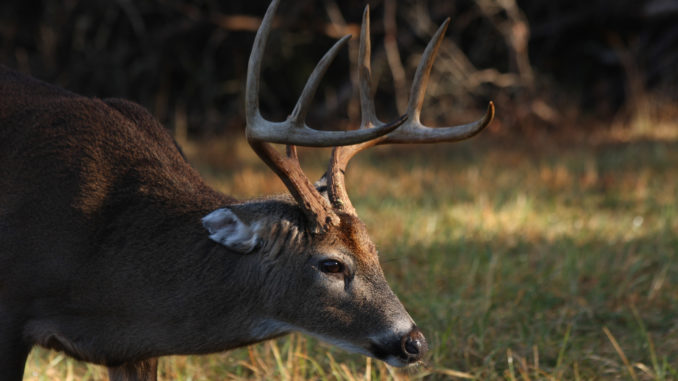
SCDNR says loss of habitat is most likely to blame
South Carolina’s deer harvest continued to slide in 2009, according to a report released in early May by the S.C. Department of Natural Resources.
Hunters took 231,703 deer statewide last season, a decrease of 6.9 percent from the 2008 harvest of 248,778. The 2009 harvest is 27.5 percent below the record harvest of 319,902 in 2002.
Charles Ruth, SCDNR’s deer and wild-turkey program coordinator, wrote I his report that the continued decline in the harvest reflects a change in habitat across South Carolina, as well as perhaps an increase in the coyote population and the effect it is having on the deer population.
“Although timber management activities stimulated significant growth in South Carolina’s deer population in the 1970s and 1980s, considerable acreage is currently in even-aged pine stands that are greater than 10 yearsd old, a situation that does not support deer densities at the same level as younger stands in which food and cover is more available,” Ruth wrote.
Ruth explained in a 2008 interview that South Carolina “got into the deer business” in the mid-1970s when extensive timber harvests changed the state’s landscape. The resulting cutovers and young stands of pines – also known as “early succession growth” – combined to jump-start the deer population.
But as the amount of timber cutting decreased and the age of the replanted pine stands increased, the cover and food available to deer decreased, resulting in a decline in the population. Harvest levels reflect the health and growth or decline of the population, Ruth explained.
Top counties in the 2009 harvest report should be familiar names to South Carolina hunters. More than 12,000 deer were reported killed in Orangeburg County, with almost 11,000 taken in Colleton County. Williamsburg County was third with a harvest of 8,176, and Hampton and Florence counties rounded out the top five with 7,356 and 7,243 deer, respectively.
A total of 14 counties had harvests of 6,000 deer or better, and five more reported harvests in excess of 5,000.
None of the counties that topped the state in total harvest made the top five in the harvest-per-unit-area rankings – which really indicate which counties were the most productive.
Bamberg County hunters took 6,893 deer in 2009, or 22.4 deer per square mile. Allendale County was second at 18.7, followed by Union at 17.7, Anderson at 17.4 and Calhoun at 17.1. Of those counties, only Union County covers more than 400 square miles – 402 to be exact.
Ruth’s report indicated that the overall rate of success for hunters last year was 69.6 – 70 percent for residents and 67.4 percent for non-residents. Bamberg County had the only appreciable number of non-resident hunters.
As in previous seasons, centerfire rifles accounted for the lion’s share (78 percent) of all deer killed, with shotguns (11 percent) and archery equipment (6.8 percent) contributing significantly. Muzzleloaders, crossbows and handguns accounted for less than five percent of the overall deer harvest. Ruth’s survey indicated that almost 80 percent of all hunters used different kinds of weapons during the season – 78 percent rifles, 12 percent archery equipment and 8.1 percent shotguns.
October was the most-productive month for hunters, with close to 32 percent of all deer taken during that month. About 30 percent of the harvest came in November, with December accounting for slightly more than 20 percent. Slightly more than 10 percent of the total harvest was in September, with less than five percent coming in August.
Statewide, 55 percent of all antlered bucks taken were 1-1/2-year-old animals. On the average, they weighed 107.3 pounds and carried 3.6 points and a 7.4-inch outside spread. Forty-four percent of 1-1/2-year-old bucks taken were spikes. Bucks 2-1/2 years and older averaged 137.9 pounds in body weight, carried racks with 6.5 points that were 12.4 inches wide.
The heaviest bucks in South Carolina, on the average, came from Lexington, Aiken, Barnwell, Lancaster and Darlington counties, with the best antler characteristics seen in Clarendon, Greenville, Lancaster, Aiken and Lexington counties.
The expansion of the coyote herd has been a topic of discussion among big-game and small-game hunters over the past decade. Although rodents and small mammals are thought to make up the majority of a coyote’s diet, Ruth said a study being done on the Savannah River Site would indicate that coyotes are having an impact on the deer herd.
“SCDNR is currently involved in a major study with researchers at the Savannah River Site, investigating the affects coyotes are having on the survival of deer fawns,” Ruth wrote. “Cumulative data through three years indicates approximately 80-percent total fawn mortality, with coyotes responsible for approximately 70 percent of these mortalities.
“If these findings even moderately represent a statewide situation, this ‘new mortality factor’ is clearly involved in the reduction in deer numbers.”
Ruth’s deer report includes a report on coyotes, highlighting an “exponential” increase in the number of coyotes killed by hunters beginning in the late 1990s.
Ruth said the SCDNR mail-survey came up with a 2009 statewide harvest of 29,783 coyotes, a 14.3-percent increase over 2008, with coyotes harvested in all of the state’s counties.
SCDNR’s research also indicated a decline in the number of wild hogs harvested across the state in 2009. Hunters took 36,888 hogs last season, a drop of 9.4 percent over 2008 levels. Hogs were killed in 42 of South Carolina’s 46 counties.



Be the first to comment